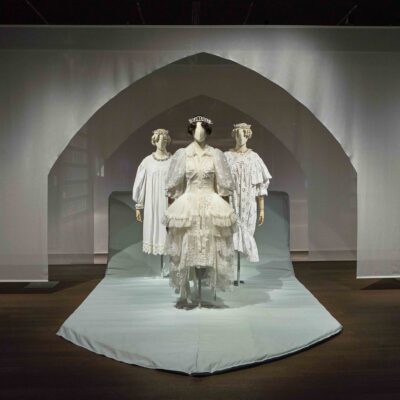
Exhibitions 21.11.2025
06.02.2023
European fashionfashion collectionPortuguese Fashion
Treasured stories from the MUDE collection: how Portuguese Designers embed Portuguese History in their work
Several national designers resort to episodes in the History of Portugal to create their works.
For Spring/Summer 2011, Maria Gambina presented her Inês D’Castro collection according to three acts: Inês as a young woman in love, Inês victim of murder, and crowned Inês. Through her keen eye for streetwear and sportswear and combining it with her reinterpretation of 14th-century costume details, Gambina portrays her vision of Inês de Castro. Some of these elements, like the ruff collar, are associated with the Galician origins of the monarch and her relation to the Spanish Court, thus portraying a young Inês de Castro. Others, like the decaying fruits and flowers prints, and the representation of the hybrid figure of the Griffin, depict her murder, and the divine power of love in the posthumous coronation of the monarch. It is worth highlighting the terrycloth sweatshirt which features open sleeves reminiscent of 14th century sleeves à rebras worn by nobility, as well as Luis de Camões’ verses embroidered on the inside of the hood: “O grief, most dreadful, painful and profound! | By which the gloomy sepulchers were spurned, | And she, who naught in life but anguish found | Even after her decease, as rightful Queen was crowned.”
For their Spring/Summer 2012 collection, the design-duo Storytailors focused on the character of Inês de Castro. Along with the corsetière Armando Gabriel, they reinterpreted the corset, one of their trademark garments, creating an ensemble in silk dupion, tulle, and silk organza with lace appliqué. The combination of the lace appliqué evoking the human skeleton in the corset and the ethereal silk organza skirt represents the moment of the Queen’s post-mortem coronation. The work of Storytailors is noteworthy and highlights their storytelling ability.
Each collection corresponds to a chapter of a bigger picture, with fictional characters based on their texts and sketches. These romanticised and baroque fables are born from legends, myths, folk tales, children’s stories, historical episodes, poems, and novels with multicultural references, leading to a unique universe easily recognised by its striking tailoring look.